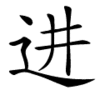进
Jump to navigation
Jump to search
| ||||||||
Translingual
[edit]| Stroke order | |||
|---|---|---|---|
| Stroke order | |||
|---|---|---|---|

| |||
Han character
[edit]进 (Kangxi radical 162, 辵+4, 7 strokes, cangjie input 卜廿廿 (YTT), four-corner 35300, composition ⿺辶井)
Derived characters
[edit]Related characters
[edit]- 進 (Orthodox traditional form)
References
[edit]- Kangxi Dictionary: not present, would follow page 1254, character 17
- Hanyu Da Zidian (first edition): volume 6, page 3818, character 4
- Unihan data for U+8FDB
Chinese
[edit]Glyph origin
[edit]Simplified from 進 (隹 → 井) in the 1956 Chinese Character Simplification Scheme by the People's Republic of China. This character is not known to have existed before that. In simplified form, Phono-semantic compound (形聲/形声) : semantic 辵 + phonetic 井 (OC *skeŋʔ).
Definitions
[edit]| For pronunciation and definitions of 进 – see 進 (“to advance; to move forward; to enter; to go into; to come into; etc.”). (This character is the simplified form of 進). |
Notes:
|
Categories:
- CJK Unified Ideographs block
- Han script characters
- Translingual lemmas
- Translingual symbols
- CJKV simplified characters
- Han phono-semantic compounds
- Beginning Mandarin
- Chinese lemmas
- Mandarin lemmas
- Sichuanese lemmas
- Dungan lemmas
- Cantonese lemmas
- Taishanese lemmas
- Gan lemmas
- Hakka lemmas
- Jin lemmas
- Northern Min lemmas
- Eastern Min lemmas
- Hokkien lemmas
- Teochew lemmas
- Wu lemmas
- Xiang lemmas
- Middle Chinese lemmas
- Old Chinese lemmas
- Chinese hanzi
- Mandarin hanzi
- Sichuanese hanzi
- Dungan hanzi
- Cantonese hanzi
- Taishanese hanzi
- Gan hanzi
- Hakka hanzi
- Jin hanzi
- Northern Min hanzi
- Eastern Min hanzi
- Hokkien hanzi
- Teochew hanzi
- Wu hanzi
- Xiang hanzi
- Middle Chinese hanzi
- Old Chinese hanzi
- Chinese verbs
- Mandarin verbs
- Sichuanese verbs
- Dungan verbs
- Cantonese verbs
- Taishanese verbs
- Gan verbs
- Hakka verbs
- Jin verbs
- Northern Min verbs
- Eastern Min verbs
- Hokkien verbs
- Teochew verbs
- Wu verbs
- Xiang verbs
- Middle Chinese verbs
- Old Chinese verbs
- Chinese classifiers
- Mandarin classifiers
- Sichuanese classifiers
- Dungan classifiers
- Cantonese classifiers
- Taishanese classifiers
- Gan classifiers
- Hakka classifiers
- Jin classifiers
- Northern Min classifiers
- Eastern Min classifiers
- Hokkien classifiers
- Teochew classifiers
- Wu classifiers
- Xiang classifiers
- Middle Chinese classifiers
- Old Chinese classifiers
- Chinese terms spelled with 进
- Chinese simplified forms